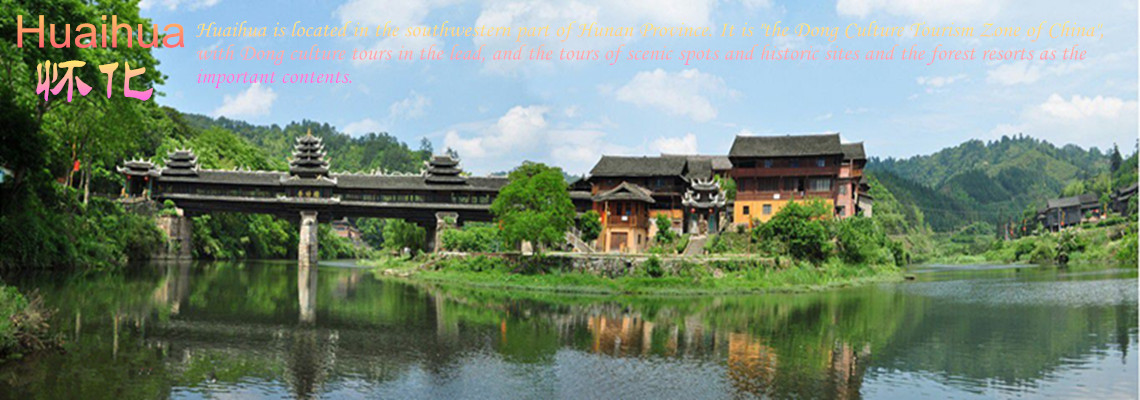
Zhijiang Travel Guide
Zhijiang County, also named Zhijiang Dong Autonomous County (simplified Chinese: 芷江侗族自治县), is under the administration of Huaihua City, Hunan province, China.Zhijiang County is bordering Tongren City of Guizhou Province to the west.In the eve of the victories that the War of China s Resistance Agaist Japan and the war of the world s resistance against fascist, it took place two important events-the meeting in Xiangxi and talking about surrender in Zhijiang. Japan officially surrendered to China near the airfield in Zhijiang On 21 August 1945. The Japanese Vice General Secretary signed the surrounding treaty, marking the end of the Second Sino-Japanese War.
What to see in Zhijiang?
Zhijiang County is situated in western Hunan at the eastern end of the Yunnan-Guizhou Plateau, amongst the southern end of the Xuefeng and Wuling Mountains. It borders Xinhuang Dong Autonomous County andGuizhou's Wanshan District and Tianzhu County to the west, Huitong County and Hongjiang Administrative District to the south, Zhongfang County and Hecheng District to the east, and Mayang Miao Autonomous County to the north.
No.1 The Memorial Hall of Accepting Japanese Surrender after the Anti-Japanese War
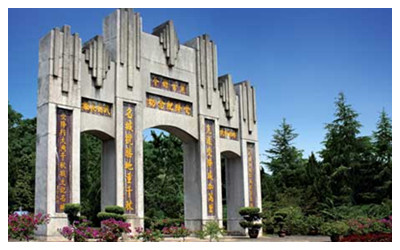 It is located at Qiliqiao in the eastern suburbs of Zhijiang County,Hunan Province's Huaihua City. It is composed of a memorial archway, the Chinese-American Air Force Club, an exhibition hall in memory of the victory over Japan and memorial stone inscriptions. This is the only group of buildings in memory of China to accept Japan's surrender.
It is located at Qiliqiao in the eastern suburbs of Zhijiang County,Hunan Province's Huaihua City. It is composed of a memorial archway, the Chinese-American Air Force Club, an exhibition hall in memory of the victory over Japan and memorial stone inscriptions. This is the only group of buildings in memory of China to accept Japan's surrender.
About 3.5 km out of the county to the west lies a stone bridge called the Qili Bridge, which means "3.5 km". A deep carving on the stone tablet at the head of the bridge reads "the place of the Japanese military surrender".A tall memorial archway across the bridge is known as "China's archway of triumph".
No.2: The Flying Tiger Memorial Hall
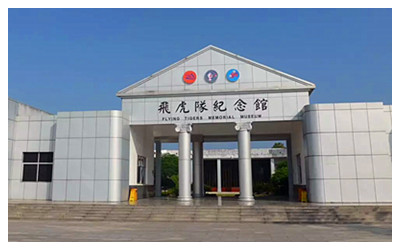 The hall is located in east of Zhijiang Airport, about 2km away from Downtown of Zhijiang County, West Hunan Province's Huaihua City. Strictly speaking, "Flying Tigers" mean the first American volunteer group who came to support China in the War of Resistance Against Japan between August, 1941 and July, 1942. The Flying Tiger Memorial Hall is An example of the China-U. S. constructive and cooperative relationship. The 1st American Volunteer Group (AVG) of the Chinese Air Force in 1941–1942, nicknamed the Flying Tigers, comprised pilots from the United States Army Air Corps (USAAC), Navy (USN), and Marine Corps (USMC), recruited under presidential authority and commanded by Claire Lee Chennault. The shark-faced nose art of the Flying Tigers remains among the most recognizable image of any individual combat aircraft or combat unit of World War II
The hall is located in east of Zhijiang Airport, about 2km away from Downtown of Zhijiang County, West Hunan Province's Huaihua City. Strictly speaking, "Flying Tigers" mean the first American volunteer group who came to support China in the War of Resistance Against Japan between August, 1941 and July, 1942. The Flying Tiger Memorial Hall is An example of the China-U. S. constructive and cooperative relationship. The 1st American Volunteer Group (AVG) of the Chinese Air Force in 1941–1942, nicknamed the Flying Tigers, comprised pilots from the United States Army Air Corps (USAAC), Navy (USN), and Marine Corps (USMC), recruited under presidential authority and commanded by Claire Lee Chennault. The shark-faced nose art of the Flying Tigers remains among the most recognizable image of any individual combat aircraft or combat unit of World War II
No.3: Longjin Roofed Bridge
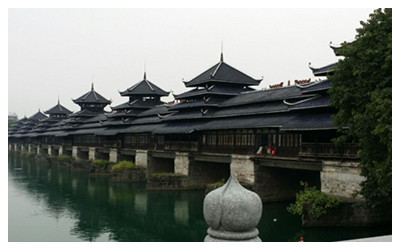 It was established without any nails and enjoys the reputation of “No 1 Bridge in Southwestern Hunan”.In 1591, the ninth year of Wanli, in Ming Dynasty, the famous monk Kuanyun took the initiative to build this bridge. Destroyed and re-built for several times, it has always been the transportation fortress of Hunan-Guizhou highroad as well as a busy place with merchants and tourists. It was called “the first bridge of Chu (ancient Chu, including Hunan, Hubei, Jiangsu, Anhui, Zhejiang)”. Longjin Roofed Bridge looks like a dragon across the river, very magnificent. It maintains well the architectural culture of Dong ethic groups and embodies the modern garden architecture arts. At the left side of the bridge, there stands “Tianhou Palace”, which is the biggest and best-preserved sea goddess temple in mainland China. The carving arts of the arched door as well as their stories are very unique.
It was established without any nails and enjoys the reputation of “No 1 Bridge in Southwestern Hunan”.In 1591, the ninth year of Wanli, in Ming Dynasty, the famous monk Kuanyun took the initiative to build this bridge. Destroyed and re-built for several times, it has always been the transportation fortress of Hunan-Guizhou highroad as well as a busy place with merchants and tourists. It was called “the first bridge of Chu (ancient Chu, including Hunan, Hubei, Jiangsu, Anhui, Zhejiang)”. Longjin Roofed Bridge looks like a dragon across the river, very magnificent. It maintains well the architectural culture of Dong ethic groups and embodies the modern garden architecture arts. At the left side of the bridge, there stands “Tianhou Palace”, which is the biggest and best-preserved sea goddess temple in mainland China. The carving arts of the arched door as well as their stories are very unique.
No.4: Zhijiang Tianhou Temple
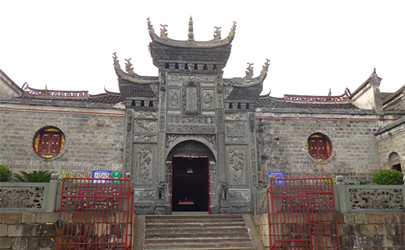 Tianhou Temple is also called "Mazu Temple" ,"Heavenly Empress Temple" . Zhijiang Tianhou Temple is the largest Mazu Temple in mainland China. Built in the year 1748, Qing Dyasty, Tianhou Temple is located at The West Street, Downtown of Zhijiang County.
Tianhou Temple is also called "Mazu Temple" ,"Heavenly Empress Temple" . Zhijiang Tianhou Temple is the largest Mazu Temple in mainland China. Built in the year 1748, Qing Dyasty, Tianhou Temple is located at The West Street, Downtown of Zhijiang County.
The front gate is made of large stone carvings in relief. It is a masterpiece of the same kind. Immortals, ghosts from legends and fairy tales, flowers, grass and even insects are depicted in these relief. The technique of hollowing out in relief sculpture can be seen here. Of the 95 relief sculptured here, each picture tells a story. If we had a microscope or telescope with us the subtle facial expression could be discerned from the characters sculptured. Reading the relief here, we can’t help feeling ourselves in the picture.
How to get there?
Tourists can get to Zhijiang County by air,train or bus.Zhijiang Airport was built in 1942 and was the second largest military airport in the Far East for the Allies during WWII. The American China-aiding air force "Flying Tiger" was once stationed here. Construction to reopen Zhijiang Airport was officially started in December 2002. By the end of 2004, 170 million yuan investment had been put into constructing Zhijiang Airport a domestic regional airport which will be able to accommodate fully loaded Boeing 737-300 airplanes. The airport is scheduled to officially open in September. Read More: Huaihua Transportation
When to visit Zhijiang?
Zhijiang County has a humid subtropical climate, with an annual mean temperature of 16.53 °C (61.8 °F). Winters are mild and brief, beginning somewhat dry and turning wet and gloomy as the season progresses. Spring is very rainy, especially in May, which is the wettest month. Summer is hot and humid (but tempered compared to much of the province), with moderate levels of rain, and generous sunshine; on average, July and August are the only two months where the area receives more than half of possible sunshine. Autumn is the driest season. From March to June, on average, more than half of the days each month receive some precipitation. The monthly 24-hour average temperature ranges from 4.9 °C (40.8 °F) in January to 27.2 °C (81.0 °F) in July. The annual precipitation is around 1,230 mm (48 in). With monthly percent possible sunshine ranging from 15% in February to 56% in August, the county receives 1,482 hours of sunshine annually.







 Ask Questions ?
Ask Questions ?